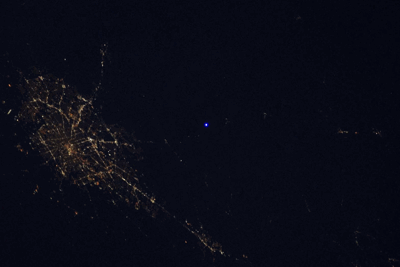Home
A comprehensive resource for safe and responsible laser use
US: College football team given 120 lasers to "make a point"
Herman was later quoted as saying “When you can see all these lasers everywhere, it just kind of represents everything that goes on in the lives of 18- to 22-year olds. We needed everybody to shut all that out and bring all that into one common focus.”
The tactic may have helped; the Houston Cougars went on to beat the Vanderbilt Commodores 34-0 on October 31 2015.
From the Houston Chronicle and Examiner.com
US: Amateur astronomers illuminate International Space Station with spotlights and 1-watt laser

Two-frame animated GIF showing bright and dim light from the Lozano Observatory (center) near the city of San Antonio (left). North is to the right in this photo from the International Space Station, taken by astronaut Don Pettit. Click on photo for a larger version.
The spotlights were flashed at the ISS by holding plywood sheets in front of the lights every two seconds. This procedure can be seen in the video below.
The animated GIF above shows a bright blue light alternating with a dim light. The bright light is almost certainly from the spotlights. The bluish tint may be an artifact of oversaturating the camera’s sensor. Astronaut Don Pettit reported that the bright light appeared white, and the dim light appeared blue. He wrote “We could only see the laser when the white light was off and not all the time.” (E.g., the white spotlights overpowered the blue laser.) He added, “It was like there were tracking issues with the laser to keep it on target.”
The dim light in the animated GIF may be the laser only, or it may be light from the spotlights that wasn’t fully blocked by the plywood sheets. The astronomers will be working with Pettit, trying to pin down exactly how visible the laser light was.